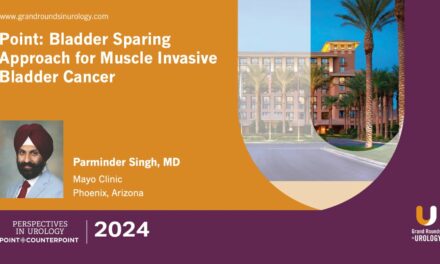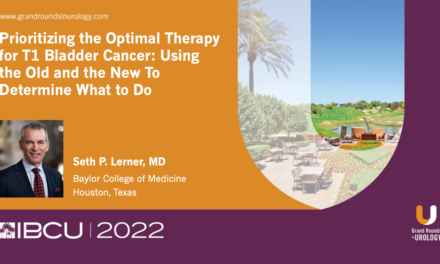Daniel A. Hamstra, MD, PhD, presented “Bladder Sparing Tri-Modal Therapy Updates” at the 26th Annual Innovations in Urologic Practice on September 15th, 2022.
How to cite: Hamstra, Daniel A. “Bladder Sparing Tri-Modal Therapy Updates” September 2022. Accessed Jul 2025. https://grandroundsinurology.com/bladder-sparing-tri-modal-therapy-updates/
Bladder Sparing Tri-Modal Therapy Updates – Summary
Daniel A. Hamstra, MD, PhD, Professor and Chair of Radiation Oncology at Baylor University, discusses the role of surgery, chemotherapy, radiotherapy (RT), and check-point inhibitors in bladder sparing therapy. He explains the North American tri-modal approach where maximal transurethral resection of bladder tumor (TURBT) and split-modality chemoradiotherapy are used. Despite excluding some patients, this treatment allows low-stage patients to retain their bladder. Dr. Hamstra next investigates the role of TURBT in this tri-modal therapy. He explains that TURBT is more apt in non-muscle invasive tumors. He illustrates that cystectomy outcomes are worse in patients who have undergone an incomplete TURBT; however, this may be because incomplete TURBT positively correlates with aggressive disease. Dr. Hamstra considers the United Kingdom approach to bladder sparing therapy. TURBT is employed if indicated, but not required for maximal debulking, and RT is given as a single block of therapy. Dr. Hamsta delves into the BC 2001 trial investigating fluorouracil (5FU) and mitomycin (MMC). Loco-regional control (LRC), invasive loco-regional control (ILRC), and bladder-specific survival are all improved. Dr. Hamsta next discusses the role of neo-adjuvant chemotherapy in chemoradiotherapy, noting that concurrent chemoradiotherapy adds value even after neo-adjuvant chemotherapy. Dr. Hamsta reiterates that surgical management is critical to success. TURBT up-front provides a role in diagnosis where maximal TURBT is desired. He discusses when cystectomy, surveillance cystoscopy, and salvage surgery may follow. Dr. Hamsta explores the necessity of radiation. He discusses multiple studies including the SWOG S2019 study in which cystectomy or observation follows neoadjuvant chemotherapy and TURBT. He continues with radiation delivery methods. He explores the use of daily radiation fractionation and associated regimens. Dr. Hamsta discusses a variety of studies on immune therapies before introducing an ongoing SWOG/NRG study on concurrent chemoradiotherapy with or without atezolizumab.
About The 26th Annual Innovations in Urologic Practice:
Presented by co-chairs Mohit Khera, MD, MBA, MPH, and Michael Coburn, MD, FACS, the Innovations in Urologic Practice conference provides a detailed review and commentary on multiple genitourinary and urologic diseases. Among the featured oncological topics are bladder cancer and immunotherapies, as well as upper tract cancer management, prostate cancer, including state-of-the-art imaging, focal therapy, and MRI. Experts also discuss new tools and techniques for nephrectomy and treating advanced renal cell carcinoma. In terms of general urological approaches, the conference also includes pelvic reconstruction and trauma; men’s health topics like male infertility, andrology, and sexual dysfunction; OAB and voiding dysfunctions; and ways to diagnose and treat infections in the urology patient.
For further educational activities from this conference, visit our collection page.
ABOUT THE AUTHOR
Daniel A. Hamstra, MD, PhD, FASTRO, FASCO, is Professor and Chair of Radiation Oncology at Baylor College of Medicine in Houston, Texas. Dr. Hamstra specializes in prostate cancer and tumors of the brain and spine with a particular focus on understanding patients’ experience both during and after treatment. His work has made a substantial impact on the growing understanding and appreciation of patient reported quality of life after radiation therapy. He has led local and national clinical trials of radiation therapy in prostate cancer and is an active member of several medical professional societies including the American Society of Clinical Oncology, the American Society of Therapeutic Radiation Oncology, and SWOG.




